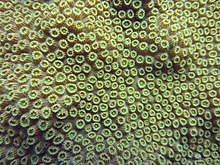Orbicella annularis, commonly known as the Boulder star coral, is a species of coral that lives in the western Atlantic Ocean and is the most thoroughly studied and most abundant species of reef-building coral in the Caribbean to date.[3] It also has a comprehensive fossil record within the Caribbean.[4][5] This species complex has long been considered a generalist that exists at depths between 0 and 80 metres (0 and 262 ft)[6] and grows into varying colony shapes (heads, columns, plates) in response to differing light conditions.[7] Only recently with the help of molecular techniques has O. annularis been shown to be a complex of at least three separate species.[8][9][10] Those species are divided into O. annularis, O. faveolata, and O. franksi. This coral was originally described as Montastraea annularis.
| Orbicella annularis | |
|---|---|

| |
| Scientific classification | |
| Domain: | Eukaryota |
| Kingdom: | Animalia |
| Phylum: | Cnidaria |
| Class: | Hexacorallia |
| Order: | Scleractinia |
| Family: | Merulinidae |
| Genus: | Orbicella |
| Species: | O. annularis
|
| Binomial name | |
| Orbicella annularis (Ellis and Solander, 1786)[2]
| |
| Synonyms[2] | |
|
List
| |

References
edit- ^ Rodríguez-Martínez, R.; Hoeksema, B.; Rivera-Sosa, A.; Croquer, A.; Villamizar, E.; Vermeij, M.; Kennedy, E.; Banaszak, A. (2022). "Orbicella annularis". IUCN Red List of Threatened Species. 2022: e.T133134A165736431. Retrieved 4 December 2023.
- ^ a b Hoeksema, Bert (2015). "Orbicella annularis (Ellis & Solander, 1786)". WoRMS. World Register of Marine Species. Retrieved 14 June 2015.
- ^ Dawson, J. P. 2006. "Quantifying the colony shape of the Montastraea annularis species complex." Coral Reefs. Vol. 25:383–389.
- ^ Budd, A. F.; Stemann, T. A.; Johnson, K. G. 1994. "Stratigraphic distributions of Neogene to recent Caribbean coral reefs." J Paleontol. Vol. 68:951–977.
- ^ Budd, A. F.; Klaus, J. S. The origin and early evolution of the Montastraea 'annularis' species complex (Anthozoa: Scleractinia)." J Paleontol. Vol. 75:527–545.
- ^ Connell, J. H. 1978. "Diversity in tropical rain forests and coral reefs." Science. Vol. 199:1302–1310.
- ^ Graus, R. R.; Macintyre, I. G. 1976. "Control of form in colonial corals: computer simulation." Science. Vol. 193:895–897.
- ^ Knowlton, N.; Weil, E.; Weigt, L. A.; Guzman, G. M. 1992. "Sibling species of Montastraea annularis, coral bleaching, and the coral climate record." Science. Vol. 255:330–333.
- ^ Weil, E.; Knowlton, N. 1994. "A multi-character analysis of the Caribbean coral Montastraea annularis (Ellis and Solander 1786) and its two sibling species, M. faveolata (Ellis and Solander 1786) and M. franksi (Gregory 1895)." Bulletin of Marine Science. Vol. 55:151–175.
- ^ Knowlton, N.; Budd, A. F. 2001. "Recognizing coral species present and past. In: Jackson JBC, Lidgard, S.; McKinney, F. K. (eds) "Evolutionary Patterns: growth, form, and tempo in the fossil record"
Further reading
edit- Lopez, J.V., Kersanach, R., Rehner, S.A., Knowlton, N. (1999) Molecular determination of species boundaries in corals: Genetic analysis of the Montastraea annularis complex using amplified fragment length polymorphisms and a microsatellite marker. Biol. Bull. 196:80–93.
- Fukami H, Budd AF, Levitan DR, Jara J, Kersanach R, Knowlton N. (2004) Geographic differences in species boundaries among members of the Montastraea annularis complex based on molecular and morphological markers. Evolution. 2004 Feb;58(2):324-37.
External links
edit- "Montastraea annularis". Integrated Taxonomic Information System. Retrieved 1 February 2008.
